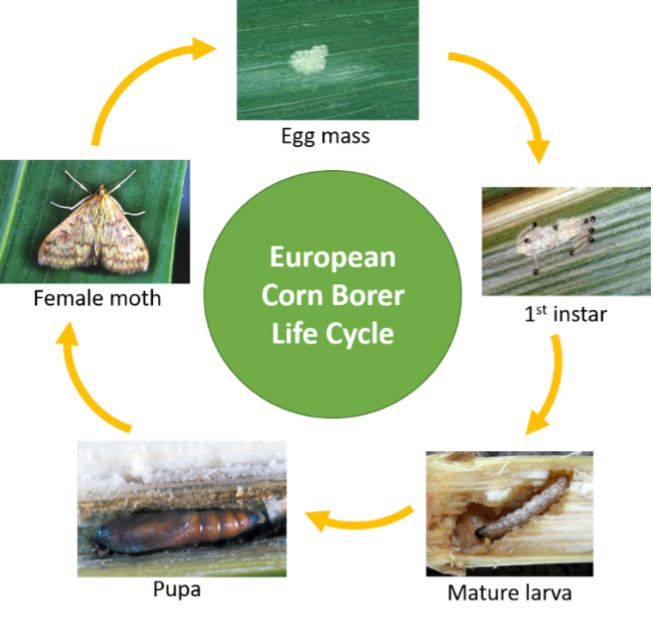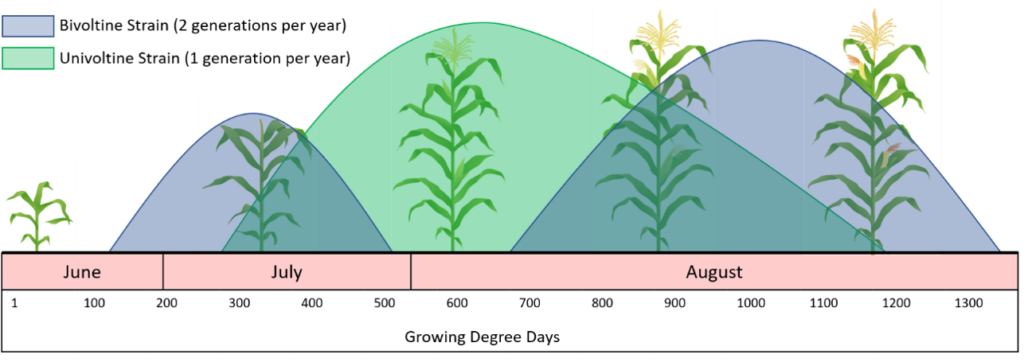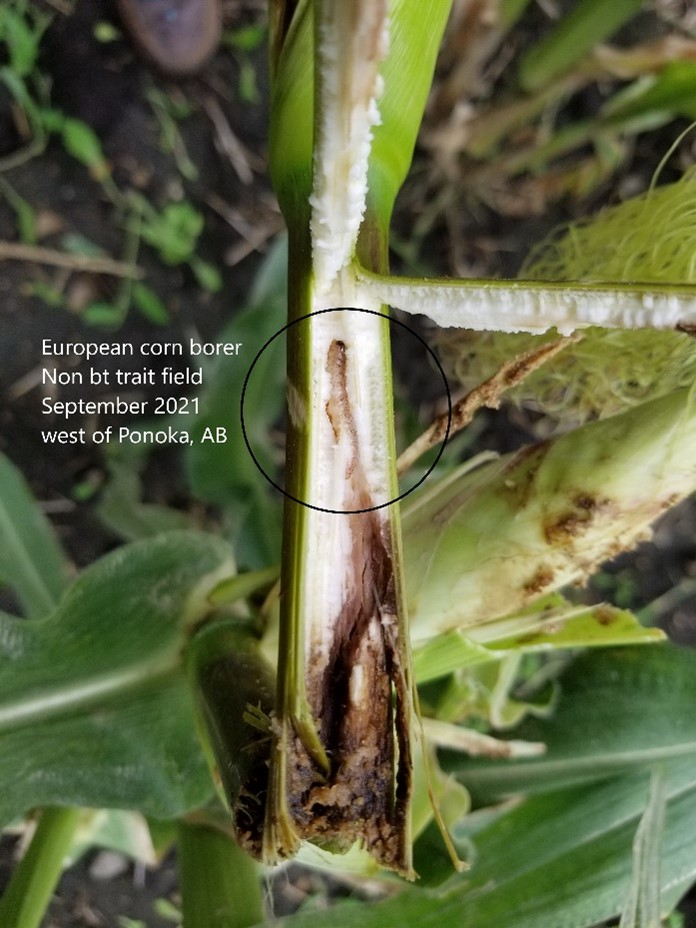European Corn Borer
August 17, 2022 | Category: Agronomy |On the Prairies, we are fortunate that we don’t have many insects to deal with when it comes to our corn production. The most prevalent insect is the European corn borer (ECB) and the pressure we see varies by year and location. The following is a summary of the lifecycle of the ECB, how the environment can impact it, and scouting techniques.
Lifecycle
Mature larvae overwinter in the corn stalks left in the field after harvest. During the early spring, these larvae pupate and become moths which chew out of the stem and emerge during late May and early June. After mating, the females lay eggs in masses on the underside of corn leaves (1st generation) near the midrib. After hatching, larvae feed for a short period on the corn leaves before migrating into the whorl where they bore into the stem where the remainder of larval development is completed.

Impact of Environment on Population Dynamics
Since eggs are laid on the underside of the leaves and the young larvae feed on the leaf surfaces before boring into the plant, hot dry conditions cause a high larval mortality among small larvae before they bore into the stem of the plant. Since these small larvae move into the corn whorl to bore into the plant, a timely rainstorm which fills up the corn whorl also causes mortality to the individuals located in the whorl. Higher temperatures during the growing season will accelerate insect development but the insect will not add an additional generation during the hot years because overwintering diapauses (hibernation) is triggered by the decreasing day-length during August when the second generation is developing in the stalk.

Impact of Environment on Crop Damage
Stalk feeding and ear feeding by corn borer larvae weaken the stalks and the ear shanks causing stalk breakage and ear drop prior to harvest. Damage is increased by strong winds in late summer and early fall before harvest. Yield can be impacted by the severing of the vascular bundles within the stalk during boring and feeding, interfering with the movement of water and photosynthesis. Crop yield and standability is also impacted with the introduction of stalk rot organisms into the corn stalk through the feeding wounds caused by the larvae entering and exiting the stalks.
Scouting
Scouting is a key factor in managing ECB in non-Bt corn fields. Identifying and counting egg masses and larvae will help determine if a control spray is warranted. Scouting of Bt corn is also needed to ensure its continued effectiveness for ECB control. Early-season moths are attracted to taller corn (early planted fields) and second-generation moths are attracted to late-planted fields that are in silking/tasseling.
Scouting Technique:
Early-season moths are attracted to taller, early planted corn fields while second-generation corn borer female moths are attracted to late-planted fields that are silking/tasselling later than normal. Examine a minimum of five sets of 20 plants (100 plants per field).
First-generation scouting — Look for leaf-feeding damage. Pull out and unroll the whorl of the damaged plants, looking for small larvae. Split the stalk of the plants from top to bottom to locate older larvae. Record the percentage of damaged plants, and number and size of larvae found.
Second-generation scouting — Look for egg masses on the underside of leaves close to the midrib of the plant. Concentrate scouting efforts to the three leaves above and below the ear of the plant. Record the percentage of plants with egg masses. Repeat scouting every 5–7 days until peak moth flights have subsided (approximately 1 month).

Economic Thresholds
Economic loss will occur when 50% of dryland grain corn plants show signs of leaf feeding (shot-holing) by newly hatched larvae. This does not appear to be the case with irrigated grain corn. (https://www.alberta.ca/economic-thresholds-for-insects-attacking-cereals-and-corn.aspx)
Manitoba Agriculture Management Worksheet for European Corn Borer in grain corn
ECB Reference Material:
https://ag.fmc.com/ca/en/fmc-videos-do-not-use/ecb-forgotten-not-gone
http://www.omafra.gov.on.ca/english/crops/pub811/pub811ch15.pdf
https://www.gov.mb.ca/agriculture/crops/insects/print,european-corn-borer.html
Danielle MacCallum CCA, P.Ag
Territory Business Manager – AB & BC
Maizex Seeds
